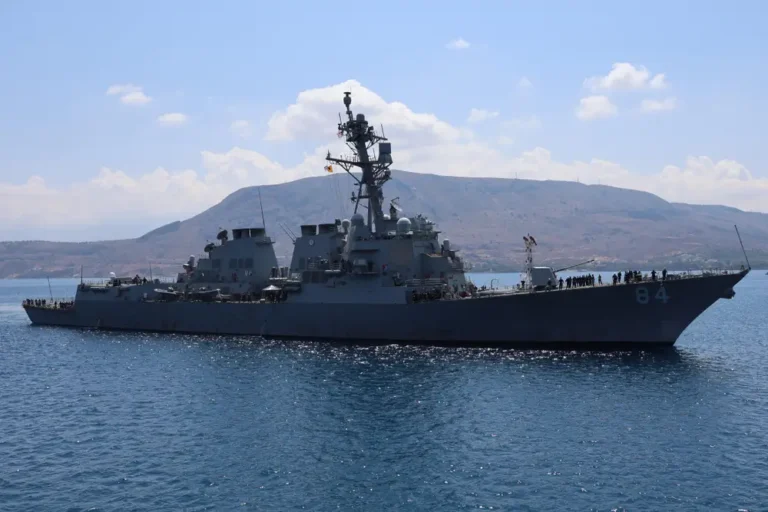China’s missile arsenal may soon rival the US. Here are the leading missiles it’s stockpiling for a big fight.
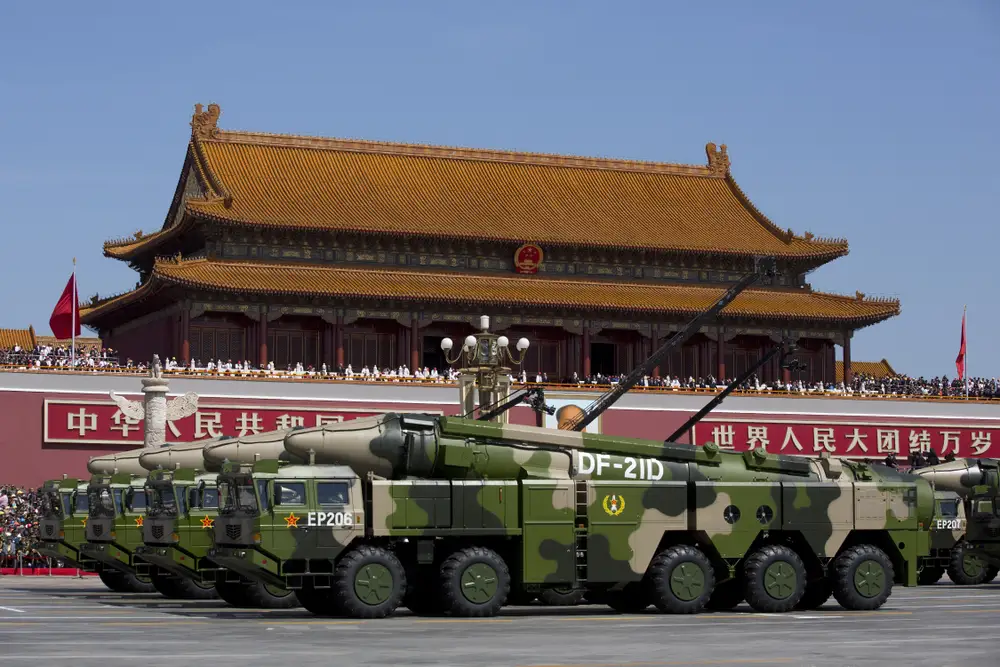
China is building a missile force with weapons like the DF-21D anti-ship ballistic missiles that can threaten the US military and some day rival it.
A reminder of China’s growing might streaked across much of the Pacific on Wednedsay.
The showy test of an intercontinental ballistic missile is part of the vast and advanced missile force China is building to threaten neighbors and negate the US military’s edge in the air and at sea.
The US believes that China’s Rocket Force has doubled the stocks of many of its missiles in recent years.
While China hasn’t revealed the size of its nuclear arsenal, the country’s nuclear arsenal is growing faster than any other country. A Pentagon report estimated that the country’s arsenal has more than 500 operational nuclear warheads — more than half of which are ICBMs.
The report also projected that China will have more than 1,000 warheads by 2030, potentially able to deploy the same number of ICBMs as the US.
Here are the major known missiles in China’s arsenal that the country is stockpiling amid heightened tensions in the Indo-Pacific.
The Carrier Killer
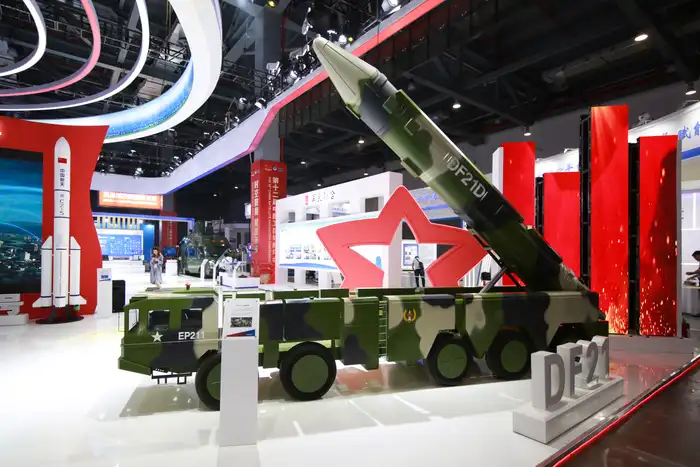
A model of DF-21D ballistic missile is on display at an expo in China.
A formidable threat to the US Navy’s prized flattop fleet, China’s infamous anti-ship Dong-Feng 21 missile has been nicknamed the “carrier killer”; Dongfeng means “east wind” in Chinese.
First introduced to service in 1991, the DF-21 is a medium-range ballistic missile with several versions, including a newer conventional anti-ship variant that could pose a threat to aircraft carriers over 1,000 miles from shore.
About the size of a city bus, the high-speed missile has a terminal homing warhead — accurate within about 65 feet of its target — that is powerful enough to at least inflict a “mission kill,” damaging a carrier enough to disable flight operations, according to Air Force Magazine.
The missile poses a serious threat to the US Navy’s fleet, but naval fighters like F/A-18 Super Hornets and F-35C Lighting fighters can also counter it.
US Navy Rear Adm. Carlos Sardiello, commander of the Carl Vinson carrier strike group, said he was confident his ships and squadrons could “operate these complex, contested domains and be lethal and survivable, and execute the mission regardless of what the threat is.”
The Guam Express
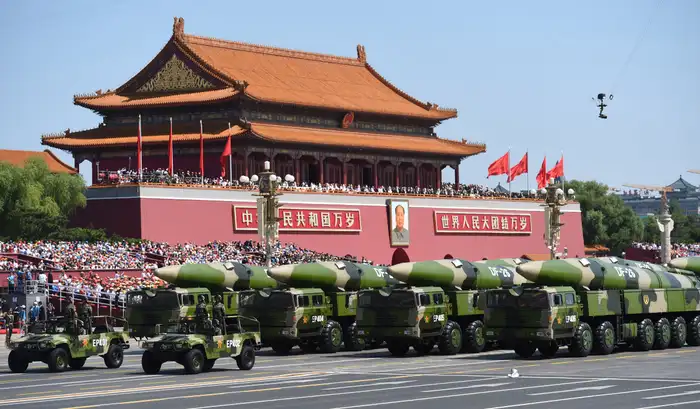
Crowds gather to observe a military parade featuring DF-26 ballistic missiles.
China’s DF-21 missiles aren’t the only anti-ship munition capable of threatening the US naval fleet. China’s Rocket Force has a growing stockpile of intermediate-range ballistic missiles known as Dong Feng-26.
The DF-26 can be armed with nuclear or conventional warheads, engaging targets on both land and sea. The IRBM’s range of up to nearly 1,900 miles allows the ballistic missile to strike US bases in Guam, earning the nickname “the Guam Express.”
During a July panel, Lt. Gen. Robert Rasch, the director of the Rapid Capabilities and Critical Technologies Office at Alabama’s Redstone Arsenal, said the growing Chinese missile threat “requires us to think differently.”
“We’re looking at a pacing threat of China that has offensive capabilities, unlike anything we’ve been seeing,” Rasch said.
Hypersonic glide vehicle

Vehicles carrying DF-17 missiles seen during a military parade.
China is ahead of Russia and the US in the race to develop hypersonic weapons.
Air defenses project a missile’s flight path and fire interceptors to hit it on that track. But this new class of weapons is designed to defeat them by flying an erratic path after the missile re-enters the Earth’s atmosphere.
A US senior defense analyst said China has the world’s “leading hypersonic arsenal,” which includes the medium-range Dong Feng-17 ballistic missile equipped with a hypersonic glide vehicle.
In service since 2019, the road-mobile missile can be armed with conventional or nuclear warheads. US intelligence estimated that, when equipped with a hypersonic warhead, the DF-17 can reach speeds of Mach 5 to 10 and have a range of up to 1,550 miles.
The missile is key to China’s efforts to deter US intervention in the Asia-Pacific region, and claims that an anti-ship variant is in development.
Meanwhile, the US is still scrambling to field its own hypersonic missile, conducting its first hypersonic weapon test with a hypersonic cruise missile in the Pacific earlier this year.
“Of course, one US test won’t shift China’s hypersonic trajectory, nor will it resolve serious concerns regarding China’s perceived hypersonic edge,” Craig Singleton, a senior fellow at the Foundation for Defense of Democracies, told CNN. “But it reaffirms that the US is not just an observer in the hypersonic domain, it’s a formidable player, and one committed to matching pace with China and Russia.”
The US also partnered with Japan, a vital ally in the Pacific, to develop a defense system to counter China’s hypersonic weapons.
Threat to Taiwan

DF-15B ballistic missiles are seen atop military vehicles in Beijing.
China’s missile arsenal poses as much of a threat to global adversaries as it does to its neighbors with short-range ballistic missiles like the DF-15.
The short-range, road-mobile missile has a maximum range of about 560 miles — capable of striking Taiwan with conventional and explosive warheads with relative ease.
China’s first ICBM
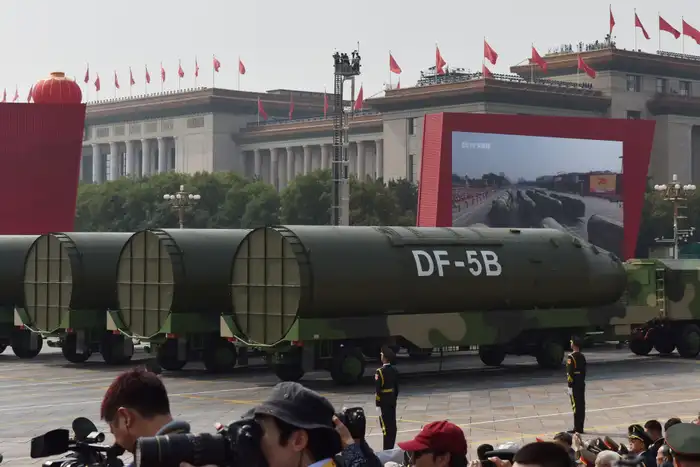
Military vehicles carrying DF-5B intercontinental ballistic missiles were showcased in a military parade at Tiananmen Square in Beijing.
China’s missile arsenal also includes an older-generation international ballistic missile, the Dong Feng-5, capable of carrying nuclear warheads to strike as far as the continental US and Western Europe.
With a range of over 8,000 miles, the silo-based ICBM can be equipped with up to 10 warheads capable of hitting different targets.
In 1980, the PLA test-launched a DF-5 missile into the South Pacific — a rare occurrence as China usually test-fires ballistic missiles in the Bohai Sea or the remote northwest region of Xinjiang.
Off-road global deterrent
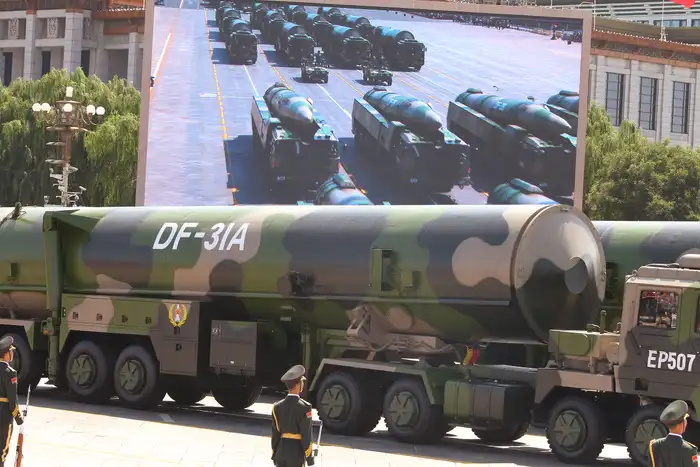
A screen shows a formation of military vehicles carrying DF-31A missiles.
Another ICBM in China’s missile arsenal is the Dong Feng-31 — a three-stage, solid-fueled missile with a tractor-trailer-based launcher — that can go off-road, expanding its potential launching area and improving the weapon’s survivability.
It can be armed with a singular warhead, capable of hitting targets with an accuracy of 500 to 1,000 feet. So far, the PLA’s Rocket Force only operates one DF-31 brigade of six launchers based in China’s Shaanxi Province, according to the CSIS Missile Defense Project.
China’s most advanced ICBM

Chinese soldiers stand near military vehicles carrying DF-41 intercontinental ballistic missiles.
The most advanced intercontinental missile in China’s arsenal is the Dong Feng-41 ICBM, capable of reaching the US and designed for nuclear deterrence.
The DF-41 has a range of up to 9,320 miles, making it China’s longest-range missile, and is reportedly capable of carrying multiple warheads that can hit different targets.
Satellite images taken in 2021 showed more than 100 new silos for nuclear missiles were being built in China, suggesting the country’s efforts to expand its “silo-based force,” according to the Pentagon.
As of October 2022, the PLA has more ICBM launchers than the US, US Air Force Gen. Anthony Cotton told lawmakers in February 2023, though he noted that the US military continues to hold the upper hand in nuclear power.
For the first time in over four decades, China on Wednesday test-fired an intercontinental ballistic missile carrying a dummy warhead into the Pacific Ocean. While it’s unclear what missile variant the PLA was testing, the launch could likely be a show of force to the US and its allies and a demonstration of the country’s advancing missile capabilities.
“There is no other potential audience, as China does not expect to have to confront the EU or the UK militarily,” Steve Tsang, director of the SOAS China Institute in London, told the Associated Press.



